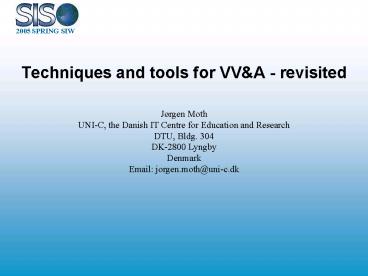Techniques and tools for VV - PowerPoint PPT Presentation
1 / 16
Title:
Techniques and tools for VV
Description:
The Target of V&V (ToVV) is developed based on the ToA. ... Requirements Engineering ... Design Of Experiments (DOE) is a powerful statistical technique for ... – PowerPoint PPT presentation
Number of Views:38
Avg rating:3.0/5.0
Title: Techniques and tools for VV
1
Techniques and tools for VVA - revisited
Jørgen Moth UNI-C, the Danish IT Centre for
Education and Research DTU, Bldg. 304 DK-2800
Lyngby Denmark Email jorgen.moth_at_uni-c.dk
2
Presentation outline
- REVVA Background
- Introduction
- The seven phases of REVVA
- ToA and ToVV
- Basic VV techniques and tools
- Requirements Engineering
- DMSO techniques
- Multi Criteria Analysis
- Experimentation techniques, DOE
- Techniques and tools for VV in the large
- Argumentation techniques
- Decision techniques
- Future directions
- Conclusions
3
REVVA Background
- Western European Armament Group's THALES
Memorandum of Understanding - JP11.20 project (nick named "REVVA")
- Common Validation, Verification and Accreditation
Framework for Simulation - March 2003 through October 2004
- France, Italy, Sweden, The Netherlands, Denmark
4
Introduction REVVA basics
- The concepts of Target of Acceptance (ToA) and
Target of Verification and Validation (ToVV) - The explicit distinction between the properties
"correctness" and "validity" of a simulation
model and the processes of "verification" and
"validation" - Hooks for the integration of methods for
estimation of uncertainty introduced by the
current inability to prove neither correctness
nor validity. - A role model, which clearly distinguishes
technical and managerial roles and sides from
which the actors may come. - A demarcation of "worlds" related to or
associated with modelling and simulation.
5
The seven Phases of REVVA
6
ToA and ToVV
- VV relevant Acceptability Criteria, which
exclusively address the models correctness and
suitability are recorded as the Target of
Acceptance, ToA. - The Target of VV (ToVV) is developed based on
the ToA. For each criterion a strategy is
developed, which points out how with the
information at hand and the available technical
means it can be demonstrated that it is passed or
failed.
7
Basic VV Techniques and Tools
- Techniques and tools primarily inherited from the
software engineering and MS disciplines. They
include - Requirements Engineering
- Informal, static, dynamic and formal techniques
for verification and validation - The basic techniques and tools are mainly
supporting the first four phases of the REVVA
process.
8
Requirements Engineering
- Are the requirements -
- complete
- consistent
- comprehensible
- unambiguous
- described in a well structured document
- traceable
- conforming and documented to defined standards?
9
DMSO Techniques
- The RPG document on VV techniques lists 77
different techniques useful for phase 2 and 4 of
the REVVA process - Multi Criteria Analysis (MCA)
- Design of Experiment (DOE)
10
Multi Criteria Analysis
- The main role of the MCA techniques is to deal
with the difficulties that human decision-makers
have been shown to have in handling large amounts
of complex information in a consistent way. - MCA techniques can be used to identify a single
most preferred option, to rank options, to
short-list a limited number of options for
subsequent detailed appraisal, or simply to
distinguish acceptable from unacceptable
possibilities.
11
Experimentation Techniques (DOE)
- Design Of Experiments (DOE) is a powerful
statistical technique for this purpose introduced
by R. A. Fisher in England in the 1920's to study
the effect of multiple variables simultaneously - DOE was later further developed and improved by
Genechi Taguchi and is today one of the most
effective quality building tools used by
engineers in all types of activities
12
Techniques and Tools for VV in the Large
- REVVA very early concluded, that to support the
full set of REVVA phases, efficient techniques
for argumentation construction and decision
support were needed. This is especially true for
the last three phases of the REVVA process.
13
Argumentation Techniques
14
Decision Techniques
- Cost/Benefit Analysis (CBA)
- Pareto Analysis
- Paired Comparison Analysis
- Grid Analysis
- Decision Trees
- Plus/Minus/Implications (PMI)
- Force Field Analysis
- Six Thinking Hats
- Multi-criteria analysis (MCA)
15
Future Directions
- Integrate Bayesian Belief Networks (BBNs) with
the Goal Structuring Notation (GSN) approach. - Whereas GSN provides a means of presenting
(essentially non-weighted) inferences between the
claims of a safety argument, - BBNs provide a means of deriving, modelling and
quantifying the belief in the inferences between
claims. - Develop a supports tool for REVVA
16
Conclusions
- We have identified a number of techniques that
complement DMSOs RPGs to cover the full REVVA
VVA process. - Still some research remains to locate operational
techniques for evidence evaluation in the vein of
jurisprudential science. - A comprehensive tool to support all the seven
phases of the REVVA process should soon be
developed, preferably as part of the coming
REVVA2 project.































